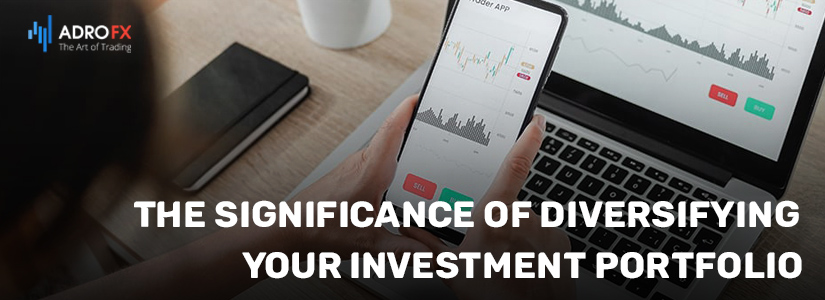The Significance of Diversifying Your Investment Portfolio

Investing serves as the cornerstone of wealth-building for many individuals. When it comes to investing, diversification stands out as a pivotal strategy to strike the right balance between growth and risk tailored to your unique financial situation. Diversification hinges on the allocation of your investments among various asset types, encompassing stocks, bonds, and cash.
In this article, we will learn what diversification is, why it really matters, and will cover some pros and cons of portfolio diversification.
Understanding Portfolio Diversification
Diversifying investments can be likened to the age-old wisdom of "not putting all your eggs in one basket." It is often accomplished through asset allocation across your investment portfolio. As aptly described by the Securities and Exchange Commission, "Asset allocation involves dividing an investment portfolio among different asset categories, such as stocks, bonds, and cash. The process of determining which mix of assets to hold in your portfolio is a very personal one. The asset allocation that works best for you at any given point in your life will depend largely on your time horizon and your ability to tolerate risk."
When considering the diversification of your portfolio, here are some key aspects to keep in mind.
Diversify Across Asset Classes
Asset classes - ranging from stocks, and bonds, to cash - typically respond differently to comparable market and economic conditions. Within the expansive asset class of stocks, you'll find various sub-asset classes, encompassing large, small, and mid-cap stocks. Furthermore, there are different styles within stocks, such as growth, value, or a combination of both. The stock market extends to domestic and international spheres, including developed countries and emerging markets.
Bonds, too, come in diverse forms. Real estate constitutes another distinct asset class, while alternative investments like cryptocurrencies and precious metals have garnered attention.
In determining the right asset allocation for your portfolio, it's imperative to evaluate the overall potential for risk and return. Additionally, you should examine how various asset classes correlate with each other, as this plays a crucial role in crafting a well-balanced and diversified investment strategy.
Achieving Global Diversification
Expanding diversification beyond national borders introduces another layer of risk management to your investment strategy. Incorporating stocks and bonds from US-based and international entities adds an extra dimension to your portfolio. The value of the US dollar concerning other currencies plays a crucial role in determining the returns on these securities for US investors.
Moreover, the distinctive economic landscapes of foreign countries exert their influence on stock prices and bond yields, further enhancing diversification. This factor alone underscores the value of diversifying across various countries and regions.
Sectoral and Industrial Diversification
For those primarily invested in stocks, diversifying across industries and sectors is of paramount importance. The performance of stocks from different sectors can exhibit significant variations. Consider the stark contrast between the factors influencing technology sector stocks and those impacting energy sector stocks. Diversifying across sectors acts as a risk mitigation strategy, helping your portfolio weather sector-specific fluctuations.
Diverse Bonds for Enhanced Portfolio Stability
In the realm of bonds, it's crucial to diversify across different bond types. Bond prices often move inversely to changes in interest rates. When interest rates rise, bond prices tend to fall, and conversely, they rise when interest rates fall. Nevertheless, other factors also influence bond prices in the secondary market:
- Time to Maturity: Bonds with longer maturities are more sensitive to interest rate fluctuations.
- Credit Quality: The creditworthiness of the bond issuer affects sensitivity to interest rate changes.
- Foreign Exchange Rates: Bonds issued outside the United States are influenced by the US dollar's relative value to the currency of the issuing country.
Leveraging Mutual Funds and ETFs for Diversification
Mutual funds and exchange-traded funds (ETFs) serve as valuable tools for diversifying your investment portfolio. These investment vehicles typically align with specific asset classes, be it stocks, bonds, or cash. Balanced funds, for instance, allocate portions of the fund to both stocks and bonds, offering an inherent diversification feature.
Optimal diversification can be achieved by holding a mix of mutual funds and ETFs. This might encompass an index fund mirroring the S&P 500 or the entire US stock market. Complementing these, you can include bond funds, funds tracking non-US stock markets, and others.
Mutual funds and ETFs not only facilitate diversification across asset classes but also pool multiple stocks, bonds, or other securities within each fund. This layered approach further enhances diversification by spreading risk across a broad range of assets.
Lastly, for investors with limited capital, mutual funds, and ETFs offer a cost-effective means of diversification when compared to assembling a portfolio of individual stocks and bonds. This affordability makes it an attractive option for those entering the world of investment.

The Significance of Diversification in Your Investment Portfolio
The importance of diversification in your investment portfolio cannot be overstated. Different types of investments exhibit varying behaviors under diverse economic and market conditions, making diversification a crucial tool for managing investment risk.
Consider this: US large-cap stocks and bonds have a correlation of 0.26, as per the JP Morgan Asset Management Guide to the Markets. In simpler terms, 26% of their returns are influenced by similar factors, while the remaining 74% depend on distinct elements.
This implies that during periods when US stocks yield negative returns, bonds may behave differently due to their low correlation with stocks. In essence, the level of correlation varies among different asset classes. A well-structured portfolio that includes an array of asset classes and investment types empowers investors to fine-tune the risk exposure in their holdings.
The Pros and Cons of Investment Diversification
Pros:
- Enhanced Risk-Adjusted Returns: Diversification contributes to improved risk-adjusted returns.
- Loss Mitigation: It helps mitigate losses during stock market downturns and economic uncertainties.
- Varied Performance: Different assets perform dissimilarly under specific market conditions, reducing overall portfolio losses.
- Capital Preservation: For older investors nearing in retirement, diversification can help protect their capital.
Cons:
- Complexity: Managing an overly diversified portfolio can be challenging, particularly when monitoring numerous holdings.
- Costs: Diversifying a portfolio can lead to higher expenses due to fees associated with certain investments.
- Risk Mitigation, Not Elimination: While diversification reduces portfolio risk, it does not eliminate it.
The Optimal Level of Diversification
There is no one-size-fits-all answer to this question. At a minimum, your portfolio should incorporate investments with low correlations to the rest of your holdings.
Typically, stocks serve as the core asset in many portfolios. Depending on your risk tolerance and investment horizon, you may consider including assets like bonds, precious metals, or commodities, all of which have limited correlations with stocks. Even within the realm of stocks, foreign and emerging market equities exhibit relatively low correlations with large-cap US stocks.
Leveraging mutual funds and ETFs specializing in various asset classes is a reliable diversification approach. However, it's essential to comprehend the underlying holdings of these funds. Investors sometimes mistakenly believe they are well-diversified by holding a few mutual funds and ETFs, only to discover that these funds share many of the same stocks and bonds.
Final Thoughts
The significance of diversifying your investment portfolio cannot be overstated. Diversification is not merely a financial strategy; it is a powerful tool for managing investment risk, enhancing returns, and achieving long-term financial goals. The key takeaway from this exploration of diversification is that it serves as a shield against the uncertainties of the financial world. By spreading your investments across different asset classes, geographical regions, sectors, and even investment types, you reduce the impact of negative market events on your overall portfolio. This approach enables you to weather market fluctuations and economic uncertainties with greater resilience.
Diversification is not a one-size-fits-all concept; rather, it's a personalized journey. It requires careful consideration of your financial objectives, risk tolerance, and time horizon. The ideal mix of assets in your portfolio may vary from one investor to another. However, the common thread is the need to avoid putting all your eggs in one basket, or in other words, to refrain from relying on a single investment or asset class to secure your financial future.
While diversification does have its complexities and may entail additional costs, its potential benefits far outweigh the drawbacks. Diversification provides a balance between growth and risk, ultimately contributing to a more stable and resilient investment portfolio.
In an ever-changing financial landscape, diversification remains a timeless and essential strategy for investors. It offers a pathway to better risk management, loss mitigation, and, ultimately, the realization of your financial aspirations. Whether you're just starting your investment journey or have been navigating the markets for years, the significance of diversification in your investment portfolio should always remain at the forefront of your financial strategy.
About AdroFx
Established in 2018, AdroFx is known for its high technology and its ability to deliver high-quality brokerage services in more than 200 countries around the world. AdroFx makes every effort to keep its customers satisfied and to meet all the trading needs of any trader. With the five types of trading accounts, we have all it takes to fit any traders` needs and styles. The company provides access to 115+ trading instruments, including currencies, metals, stocks, and cryptocurrencies, which make it possible to make the most out of trading on the financial markets. Considering all the above, AdroFx is the perfect variant for anyone who doesn't settle for less than the best.











